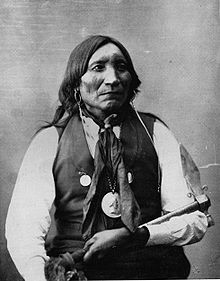Guipago
| Guipago | |
|---|---|

Guipago (Lone Wolf), Principal Kiowa Chief of the Kiowa Tribe. Medal was presented to Chief Guipago by President Buchanan. General Sheridan stated that he could not give this chief any slack
|
|
| Native name | Gui'pago (Lone Wolf) |
| Born | ca 1820 |
| Died | July 0, 1879 (aged 58–59) Fort Sill, Oklahoma |
| Cause of death | Malaria |
| Resting place | Mount Scott area (Wichita Mountains), Oklahoma |
| Nationality | Kiowa |
| Known for | A chief of the Kiowa Nation, warrior, orator |
| Relatives | Chief Dohasan (Uncle) |
Guipago (Gui-pah-gho, or Lone Wolf [the Elder] ) (ca.1820 – july 1879) was the last Principal Chief of the Kiowa tribe. He was a member of the Koitsenko, the Kiowa warrior elite, and was a signer of the Little Arkansas Treaty in 1865.
The Kiowa flourished as nomadic hunters in the early 19th Century. In 1807, they allied with the Comanche in a treaty drawn up by the Spanish Americans at Las Vegas, NM. In 1863 Lone Wolf (Guipago), accompanied Yellow Wolf, Yellow Buffalo, Little Heart, and White Face Buffalo Calf; two Kiowa women Coy and Etla; and the Indian agent, Samuel G. Colley, to Washington D. C. to establish a policy that would favor the Kiowa, but it was a futile attempt.
In the Little Arkansas Treaty of 1865 Dohasan the last Chief of the unified Kiowa signed the peace treaty along with Guipago (Lone Wolf) and other chiefs. Dohasan scorned the peace policy because he knew there would be no more buffalo in Kiowa hunting grounds and Guipago also knew the Kiowas could not live without buffalo hunts. In the following years Guipago, along with Satanta (White Bear), old Satank (Sitting Bear) the leader of Koitsenko Warrior Society, Zepko-ete (Big Bow), Manyi-ten (Woman's Heart), Set-imkia (Stumbling Bear), Aupia-goodle (Red Otter), Tsen-tainte (White Horse), Ado-ete (Big Tree) led many raids in Texas and Oklahoma, and in Mexico too, playing his very important role as political antagonist of Tene-angopte (Kicking Bird)'s appeasement politics.
October 21, 1867, Guipago did not sign the Medicine Lodge Treaty. The Medicine Lodge Treaty led to the United States taking possession of 2,001,933 acres of the Kiowa, Comanche, and Plains Apache Reservation. This does not include the 23,000 acres of the Fort Sill Military Reservation. The Medicine Lodge Treaty placed the Kiowa on a reservation in western Oklahoma and the government supervised the activities of the Kiowa. In 1868 General Sheridan planned to wipe out the Plains Indians, thus, col. George A. Custer moved onto the valley of the upper Washita River in December 1868.
...
Wikipedia
